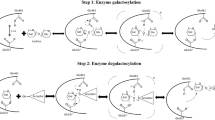Abstract
Bacillus subtilis NRC33a was able to produce both inducible and constitutive extracellular levansucrase, respectively, using sucrose and glucose as carbon source. The optimal production of the levansucrase was at 30°C. The effect of different nitrogen sources showed that baker’s yeast with 2% concentration gave the highest levansucrase activity. Addition of 0.15 g/L MgSO4 was the most favorable for levansucrase production. The enzymic synthesis of levan was studied using 60% acetone fraction. The results indicated that high enzyme concentrations produced increasing amounts of levan, and hence conversion of fructose to levan reached 84% using 1000 μg/ml enzyme protein. Sucrose concentration was the most effective factor controlling the molecular weight of the synthesized levan. The conversion of fructose to levan was maximal at 30°C. The time of reaction clearly affected the conversion of fructose to levan, which reached its maximum productivity at 18 hours (92%). Identification of levan indicated that fructose was the building unit of levan.





Similar content being viewed by others
Literature Cited
Ammar Y, Matsubara T, Itu K, Iizuka M, Limpaseni T, Ponsawasdi P, et al. (2002) Some properties of levansucrase of Bacillus natto stabilized with periodate oxidized yeast glucomannan. Enzyme Microb Technol 30:875–882
Block RJ, Durrum EL, Zweig G (1995) A manual of paper chromatography and paper electrophoresis. New York, NY: Academic, p. 127
Gross M, Ceier G, Rudolph K, Cieder K (1992) Levan and levansucrase synthesized by the fireblight pathogen Erwinia amylovora. Physiol Mol Plant Pathol 40:371–381
Keith I, Wiley B, Ball D, Arcidiacono S, Zorfass D, Mayer J, et al. (1991) Continuous culture system for production of biopolymer levan using Erwinia herbicola. Biotechnol Bioeng 38:557–560
Hermandez L, Arrieta J, Menendez C, Vazquez R, Coego A, Suarez V, et al. (1995) Isolation and enzymic-properties of levansucrase secreted by Acetobacter diazotrophicus SRT4, a bacterium associated with sugar cane. Biochem J 309:113–118
Kasapis S, Morris E, Gross M, Rudolph K (1994) Solution polysaccharide from Pseudomonas syringe pv phaseolicola and its possible primary role as a blocker of recognition during pathogenesis. Carbohydr Polym 23:55–69
Laziè ML, Veljković VB, Vuxetić JI, Vrvić MM (1993) Effect of pH and aeration on dextran production by Leuconstoc mesenteroides. Enzyme Microb Technol 15:334–338
Lowry OH, Rosebrough NJ, Farr AL, Randall RJ (1951) Protein measurement with folin phenol reagent. J Biol Chem 193:265–275
Marx S, Köning S, Hartmeier W (1999) Synthesis of fructo-oligosaccharides by native and immobilized levansucrase from Zymomonas mobilis. Thirteenth Forum for Applied Biotechnology. Hept Pand, Gent, Belgium. Proceedings, Part I 64:246–251
Ohtsuka K, Hino S, Fukushima T, Ozawa O, Kanematsu T, Uchida T (1992) Characterization of levansucrase from Rhanella aquatilis JCM-1683. Biosci Biochem 56:1373–1377
Oseguera P, Guereca L, Lopez-Munguia A (1996) Properties of levansucrase from Bacillus circulans. Appl Microbiol Biotechnol 45:465–471
Sacha A, Hijum V, Bonthing K, Marc J, Maarel V, Dijkhuzen L (2001). Purification of novel fructosyltransferase from Lactobacillus reuteri strains 121 and characterization of the levan produced. FEMS Microbiol Lett 205:323–328
Vina I, Bekers M, Karsakenvich A, Linde R, Gonta S, Toma M (1998) Some properties of fructose biopolymer levan produced by Zymomonas mobilis. Biomass for Energy and Industry. Proceedings of the International Conference, pp 460–463
Yanase H, Fukushi H, Ueda N, Maeda Y, Toyoda A, Tonomura K (1991) Cloning, sequencing and characterization of the intracellular invertase gene from Zymomonas mobilis. Agric Biol Chem 55:1383–1390
Yun JW (1996) Fructo-oligosaccharides occurrence, preparation and application. Enzyme Microb Technol 19:107–117
Kaboli H, Reilly RJ (1980) Immobilisation and properties of Leuconostoc mesenteroides. Biotechnol Bioeng 22:1055–1069
Pileggi R, Khin BW (1962) Enzymatic colorimetric method. J Biol Chem 40:585–589
Kim M.G, Seo JW, Song KS, Kim CH, Chung BH, Ki-Rhee S (1998) Levan and fructosyl derivatives formation by a recombinant levansucrase from Rahnella aquatilis. Biotech Lett 20:333–336
Han WY, Clarke AM (1990) Production and characterization of microbial levan. J Agric Food Chem 38:393–39
Meng G, Futterer K (2003) Structural framework of fructosyl transfer in Bacillus subtilis levansucrase. Nat Struct Biol 10:935–41
Author information
Authors and Affiliations
Corresponding author
Rights and permissions
About this article
Cite this article
Abdel-Fattah, A.F., Mahmoud, D.A.R. & Esawy, M.A.T. Production of Levansucrase from Bacillus subtilis NRC 33a and Enzymic Synthesis of Levan and Fructo-Oligosaccharides. Curr Microbiol 51, 402–407 (2005). https://doi.org/10.1007/s00284-005-0111-1
Received:
Accepted:
Published:
Issue Date:
DOI: https://doi.org/10.1007/s00284-005-0111-1




